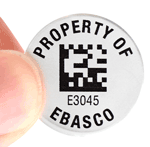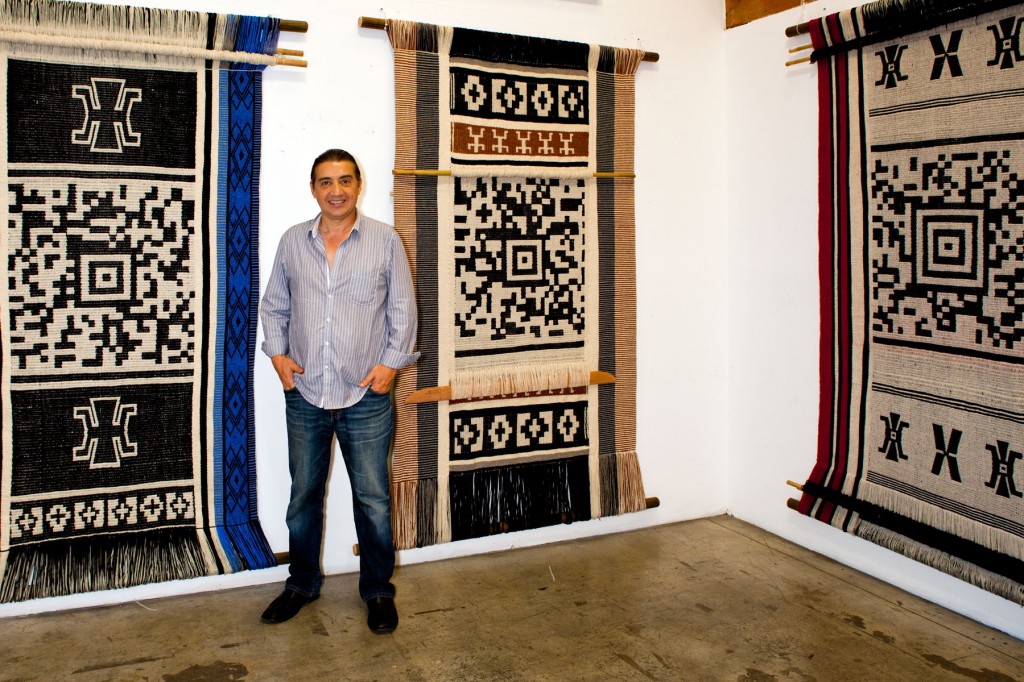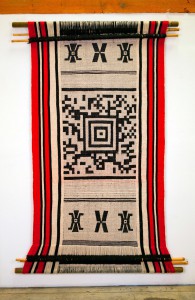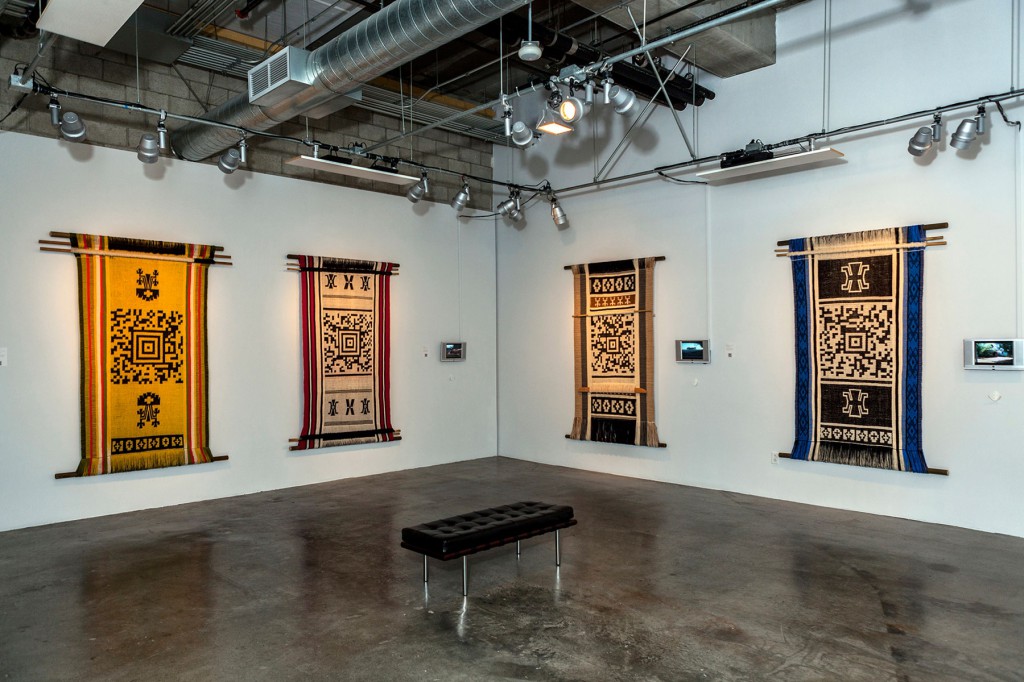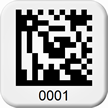Artist Guillermo Bert weaves QR codes into indigenous tapestries
When you look at a QR code, you likely see a collection of pixelated lines and shapes coded to label a product or a piece of inventory or equipment. When an artist like Guillermo Bert looks at the same QR code, he sees something entirely different.
The mixed media artist had been incorporating various kinds of encrypted symbols into his art works for a while when it occurred to him that the QR codes used in everyday commerce resembled the pictograms of some of the ancient cultures of the Americas. For the Los Angeles-based artist, the resemblance was not just a curious coincidence; it was a call to make a new kind of art.
“Bar coding is so universal; it’s right in your face, but you can’t read it,” he says. “Then I find out that the new series of bar codes looks just like traditional iconography of the indigenous peoples of the Americas.” It was an invitation to mix old and new. For the old, he chose traditional patterned textiles as his medium. For the new, QR coding beckoned. Combining the two would, he hoped, create “a new hybrid from the clashing cultures.” In the end, the mash-up worked so well that museum-goers could actually read the woven messages with their smart phones.
When he started the textile project, Bert had already been working with coded symbols and patterns. One series of mixed media works was based on Greek typography encrypted with English translations. Another group of woodcuts featured bar codes superimposed over iconic American images in an ironic commentary on what he calls “the commoditization of the world.”
He was looking for other kinds of encrypted symbols when he started studying the newer generations of bar codes. Besides the resemblance to the art of indigenous peoples, Bert realized that the new codes, with their capacity to transmit volumes of data and their use on everything from boarding passes to hospital ID bracelets, have serious implications for the concept of identity. “Your identity becomes digitized; your entire history is online. You’re losing your identity because you can’t contain it,” he says.
At the same time, he continues, “the indigenous peoples are losing their identity for different reasons. Their culture is fading, the people are dying. I thought, ‘What if I combine the [two aspects] of identity loss?’”
The project took Bert to his homeland of Chile, where he sought out members of the Mapuche community. “Mapuche” is the term applied to the surviving members of a number of indigenous Chilean tribes. Bert identified five individuals—a woodcarver, a shaman, a performer, a filmmaker and a poet—and filmed them telling their stories. He then chose the most essential quotation from each and translated it into code, using a simple coding app. He located a Mapuche master weaver, Anita Paillamil, who agreed to incorporate Bert’s designs into traditional woven textiles made from natural wool and dyed with plant-based pigments.
Bert’s first attempts to make art from the new technology centered on the PDF417 bar codes. He used Photoshop to superimpose the code over a traditional textile image. “It looked just stunning,” he says, “but it did not work” for weaving because in PDF417 codes, “nothing is aligned, the pixels are very random, very abstract.” He found a form of QR code that worked better: the appropriately named Aztec code, which takes its name from its center squares, which resemble a view of an Aztec pyramid from the air. “Aztec code worked better,” he explains. “The squares all line up. I thought because of the Latin American character, it would be more appropriate.”
Bert created five designs that combined QR coded quotations from his subjects with traditional Mapuche iconography. Then he and Paillamil worked together to figure out how to transfer the codes to the textiles. “It was a challenge precisely because it’s two different technologies that don’t belong together,” says Bert. The work proved to be so complicated that Paillamil returned with Bert to Los Angeles, where he built two looms for her to work on. She stayed for two-and-a-half months until they perfected the technique.
After two years of work, Bert’s efforts had produced five scannable tapestries, each quoting one of the Mapuche individuals Bert had interviewed. One of the codes translates as “We need the same things that a tree does. We cannot live without the land.” Another reads, “We are proof that in the 21st century, an ancestral nation still exists.”
He was thrilled that the Aztec codes actually worked and that viewers whose smart phones contained scanner apps could translate them on the spot. “I was shooting for the conceptual approach. I thought that we might not get all the way, and if it doesn’t read, we’ll leave it at that. But it works. It’s a functional bar code in tandem with the ancient technologies.”
The tapestries were displayed at the Pasadena Museum of California Art earlier this year. They are slated to be shown in New York, Denver and Santiago, Chile, over the next few years.
Meanwhile, Bert is continuing to code the words of indigenous peoples. He has already created two more textile prototypes using Zapotec symbols and is planning to go to Oaxaca, Mexico to work with the weaving communities there. He is also working with the University of Arizona to create works using Navajo-style textiles and beadwork.
So far, Guillermo Bert’s coded textiles have cost $100,000. Support has come from individual donors and a Kickstarter campaign that raised $35,000. He is hoping to find sympathetic donors, possibly from the technology sector, who can help fund future projects he envisions with the indigenous peoples of Brazil, Guatemala and Ecuador.
Bert is clearly enamored of his creations. “The technology is cold,” he says, “but I see the beauty in it. There’s an elegance that comes through. When you use the technology and get into a humanistic approach, it really makes sense.”
Category: QR codes









